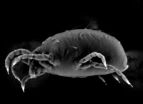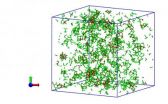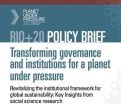(Press-News.org) SALT LAKE CITY, Nov. 23, 2011 – A University of Utah biologist and an international research team decoded the genetic blueprint of the two-spotted spider mite, raising hope for new ways to attack the major pest, which resists pesticides and destroys crops and ornamental plants worldwide.
The voracious mites, which technically are not insects, can eat more than 1,100 plant species – a rare trait. The mites' newly revealed and sequenced genome contains a variety of genes capable of detoxifying pesticides as well as toxins plants use to defend themselves, the scientists report in the Thursday, Nov. 24 issue of the journal Nature.
"One key thing that makes spider mites unique is they can eat many, many different plant species," says Richard M. Clark, one of five main authors of the study and an assistant professor of biology at the University of Utah. "These mites are often house plant pests – a major cause of people's house plants turning yellow and getting sick. They also are a major problem for agricultural nurseries and greenhouses, and for field crops."
Primary targets are tomatoes, peppers, cucumbers, strawberries, corn, soybeans, apples, grapes and citrus.
Clark says the new study's "importance is largely in understanding how animals eat plants, with the long-term goal of developing effective ways to prevent crop damage from mites and insects. If we can identify the biological pathways mites use to feed on plants, we can potentially identify chemical and biological methods to disrupt those pathways and stop the mites from feeding."
The two-spotted spider mite, which is no more than 1 millimeter long, "is a major global pest, and is predicted to be a growing concern in a warming climate because they multiply extremely fast at high temperatures – 90 degrees Fahrenheit or more," he adds. "They do really well in hot and dry climates like Utah."
Yet, the two-spotted spider mite "has been found to rapidly develop resistance to multiple types of pesticides, often within a couple of years after a pesticide is introduced," says Clark. "It is resistant to many common pesticides used against insects."
The Nature study deciphering the genome of Tetranychus urticae, the two-spotted spider mite (which has two red spots), was conducted by an international research team of 55 scientists from North America, Europe and South America.
Besides Clark, the other primary authors are biologists Yves Van de Peer of Ghent University and the Flanders Institute for Biotechnology in Belgium; Miodrag Grbic of the University of Western Ontario, Canada; Thomas Van Leeuwen of Ghent University; and Rene Feyereisen of the University of Nice Sophia Antipolis in France.
Genetic Blueprint of the Two-Spotted Spider Mite
Decoding the spider mite's genome required dozens of scientists with expertise in various gene families. Clark mainly studied which genes are "expressed" or activated and thus make messenger RNA, or mRNA, which in turn is used to make proteins.
The study found that the two-spotted spider mite has 18,414 genes. Clark and University of Utah graduate student Edward J. Osborne found that 15,397 genes are "expressed" or activated to make proteins.
The spider mite genome contains about 90 megabases – that's 90 million "base pairs" of DNA letters (A,C, G and T) – which is the smallest genome yet sequenced for any arthropod, which are invertebrate or spineless animals with external skeletons or exoskeletons, segmented bodies, and appendages with joints.
"Many of the other genomes are enormous," some close to 3 billion bases, or about the size of the human genome, and some up to 7.1 billion bases, Clark says.
Arthropods include hexapods (insects and insect-like animals), crustaceans (lobsters, crabs, shrimp, barnacles), myriapods (millipedes, centipedes) and chelicerates (spiders, scorpions, mites and ticks). Chelicerates are the largest group of animals after insects. The two-spotted spider mite is the first chelicerate to have its genome fully sequenced.
While there are other species of plant-feeding mites, the researchers chose to sequence the genome of the two-spotted spider mite "because of all the spider mites, this is the most widespread because it feeds on so many different plant species," Clark says.
The study's findings shed light on how the spider mites evolved differently than other arthropods. Compared with other arthropods, the two-spotted spider mite:
Uses a different molting hormone to shed its exoskeleton during growth.
Has only eight Hox genes to orchestrate body-plan development, compared with 10 in most other arthropods, and thus has only two main body segments instead of three. There are other cases in which Hox genes were activated differently in different arthropods, "but this is an extreme case," Clark says. "The genes are both gone.
Makes silk that is strong like spider silk but 185 to 435 times thinner. "Spiders spin silk from their abdomens, spider mites from the head region," Clark says. Spider mites use silk to hide from predators, keep themselves warm, and suspend eggs out of predators' reach. Silk from the mites may prove useful as biodegradable surgical sutures and bandages. It "is very thin and very easy to get because you can grow lots of mites on plants," Clark says.
A Genetic Arsenal to Attack Plant Toxins and Pesticides
The spider mite genome also revealed the presence of "families of genes involved in breaking down toxic compounds, either in plants poisonous to the spider mites or in pesticides," says Clark. "You would imagine that if these mites feed on such a broad number of plant hosts, they would have many genes known to be involved in breaking down toxic compounds. And we found that they did."
In some specific families of detoxification genes in the spider mites, "the number of genes was about three times that seen in other arthropods," he adds.
As part of the study, the scientists took a specific strain of spider mites that normally eat kidney beans and transferred them to tomato and thale cress (Arabidopsis) plants. On these new plants, the mites "expressed" or activated different genes and thus made different detoxification compounds so they could eat the new plant species. Some of those detox genes were previously unknown and thus provide new insight into how mites counteract plant defenses.
For example, half of the cytochrome P450 family of detoxification genes changed expression – turned either on or off – when the mites were switched to the new plants. That is a bigger change than seen before in any group of animals, Clark says.
"This suggests that these genes are critical for the ability of mites to be pests on many different plants."
Clark says the spider mite has 39 genes from one drug-resistance gene family (and the proteins they encode), compared with only nine to 14 in insects and vertebrate animals. That shows how an expanded set of genes evolved to help the pests feed on numerous plant species.
In a yet-unexplained mystery, the two-spotted spider mite has some genes similar to those in bacteria and fungi. "They somehow captured them from other organisms in the environment and now are using them for their own growth and persistence," says Clark. "They are mostly enzymes involved in changing other small molecules. The hypothesis is these genes may be involved in modifying [detoxifying] toxic compounds found in plants."
INFORMATION:
Clark's part of the study was funded by the University of Utah and the National Science Foundation. The study's key funding sources included the U.S. Department of Energy, Genome Canada and Belgium's Fund for Scientific Research Flanders.
University of Utah Public Relations
201 Presidents Circle, Room 308
Salt Lake City, Utah 84112-9017
801-581-6773 fax: 801-585-3350
http://www.unews.utah.edu
Big pest, small genome
Blueprint of spider mite may yield better pesticides
2011-11-24
ELSE PRESS RELEASES FROM THIS DATE:
Hours of Service Rules for Commercial Truck Drivers Traveling Through Atlanta
2011-11-24
Almost a year ago, the Federal Motor Carrier Safety Administration (FMCSA) proposed new limits on Hours of Service (HOS) rules for commercial drivers. While the intent was to improve highway safety for all who travel by limiting fatigue among truck drivers, the proposed changes have come under fire from trucking advocacy groups as having little impact on highway safety. The proposed changes in hours of service have not yet been finalized.
Existing Hours of Service Limitations for Commercial Drivers
HOS regulations generally apply to all drivers of commercial vehicles. ...
Supercool
2011-11-24
SALT LAKE CITY -- We drink water, bathe in it and we are made mostly of water, yet the common substance poses major mysteries. Now, University of Utah chemists may have solved one enigma by showing how cold water can get before it absolutely must freeze: 55 degrees below zero Fahrenheit.
That's 87 degrees Fahrenheit colder than what most people consider the freezing point of water, namely, 32 F.
Supercooled liquid water must become ice at minus 55 F not just because of the extreme cold, but because the molecular structure of water changes physically to form tetrahedron ...
Dana-Farber/Children's Hospital Boston study identifies possible therapy for radiation sickness
2011-11-24
BOSTON—A combination of two drugs may alleviate radiation sickness in people who have been exposed to high levels of radiation, even when the therapy is given a day after the exposure occurred, according to a study led by scientists from Dana-Farber Cancer Institute and Children's Hospital Boston.
Mouse studies of other potential therapies suggest they would be effective in humans only if administered within a few minutes or hours of radiation exposure, making them impractical for use in response to events involving mass casualties. In contrast, the larger time window ...
UN overhaul required to govern planet's life support system: Experts
2011-11-24
Reducing the risk of potential global environmental disaster requires a "constitutional moment" comparable in scale and importance to the reform of international governance that followed World War II, say experts preparing the largest scientific conference leading up to next June's Rio+20 Earth Summit.
Stark increases in natural disasters, food and water security problems and biodiversity loss are just part of the evidence that humanity may be crossing planetary boundaries and approaching dangerous tipping points. An effective environmental governance system needs to ...
Disability Insurance Claim Denied? An ERISA Lawsuit Could Help
2011-11-24
Private disability insurance can be a significant source of value for employees and their families, and they expect to be able to rely on it in their times of need. But what happens when an employee's disability insurance claim is denied?
A comprehensive federal law known as the Employee Retirement Income Security Act of 1974, or ERISA, protects the interests of participants in many types of insurance plans. ERISA sets standards for the administration of benefit plans, including the proper procedure for appealing a denial of a claim for benefits. If the claims process ...
Earth's core deprived of oxygen
2011-11-24
Washington, D.C. — The composition of the Earth's core remains a mystery. Scientists know that the liquid outer core consists mainly of iron, but it is believed that small amounts of some other elements are present as well. Oxygen is the most abundant element in the planet, so it is not unreasonable to expect oxygen might be one of the dominant "light elements" in the core. However, new research from a team including Carnegie's Yingwei Fei shows that oxygen does not have a major presence in the outer core. This has major implications for our understanding of the period ...
New butterfly species identified in Yucatan peninsula
2011-11-24
About 160,000 species of butterflies and moths are already known, but scientists believe that a similar number still remain undiscovered. Identification and characterization of these species can be complicated by the fact that each species has an immature caterpillar and a mature butterfly form, as well as the reliance on the physical appearance for classification.
Now, though, researchers report that a type of DNA analysis called "barcoding" may provide a powerful tool in this effort, according to a study published in the Nov. 16 issue of the online journal PLoS ONE. ...
Public restrooms ripe with bacteria, study says
2011-11-24
Everyone wonders what bugs might be lurking in public bathrooms. Now researchers are using novel genetic sequencing methods to answer this question, revealing a plethora of bacteria all around, from the doors and the floors to the faucet handles and toilet seats, with potential public health implications, as reported Nov. 23 in the online journal PLoS ONE.
Led by Gilberto Flores and Noah Fierer of the University of Colorado, Boulder, the researchers investigated 12 public restrooms, 6 male and 6 female, in Colorado. Using a high-throughput genetic sequencing technique, ...
Overweight individuals more susceptible to risk factors for further weight gain
2011-11-24
Some risk factors for obesity become stronger the more overweight a person is, according to a study published Nov. 23 in the online journal PLoS ONE.
Paul Williams of Lawrence Berkeley National Laboratory in Berkeley, California found that certain risk factors – lower education level, parental obesity, and high meat/low fruit diets – produced a greater risk for excess body weight for subjects with a higher body mass index (BMI) than for those with lower BMI.
Based on these results, Williams proposes that environmental factors that result in little to no weight gain ...
Doctors can do better if they learn from their mistakes
2011-11-24
We rely on our doctors to make appropriate decisions for our treatment, but this process can be subject to a variety of potentially conflicting influences. To identify what makes a good decision-maker, a team of researchers, led by Read Montague, PhD, director of the Human Neuroimaging Laboratory at Virginia Tech Carilion Research Institute, tested 35 experienced physicians for their ability to make appropriate treatment choices, and found that the doctors who performed best were those who learned from both their successes and failures, rather than focusing just on the ...
LAST 30 PRESS RELEASES:
Fertility remains high in rural Tanzania despite access to family planning
AI-assisted device can improve autism care access
Kinetic careers
Uncovering how parasitic plants avoid attacking themselves to improve crop resistance
Nanoparticle vaccine strategy could protect against Ebola and other deadly filoviruses
Study finds brain care score can predict risk of stroke across racial groups
Key lung immune cells can intensify allergic reactions
Do hormones explain why women experience more gut pain?
New materials conduct ions in solids as easily as in liquids
Breakthrough of the Year: Renewable energy begins to eclipse fossil fuel-based sources
LLM use is reshaping scientific enterprise by increasing output, reducing quality and more
Introducing LightGen, a chip for ultra-fast, ultra-efficient generative AI
Astronomers see fireworks from violent collisions around nearby star
ACC/AHA issue new guideline on managing congenital heart disease in adults
Cosmic crash caught on camera
Is talented youth nurtured the wrong way? New study shows: top performers develop differently than assumed
Ants: An untapped resource in the development of antibiotics?
Archaeologists use AI to create prehistoric video game
Mitochondria migrate toward the cell membrane in response to high glucose levels
Tiny viral switch offers hope against drug-resistant bacteria
Most parents aware of early peanut introduction guidelines, but confused about details
HPV vaccine can protect against severe lesions of the vulva and vagina
Virtual care provision and emergency department use among children and youth
Quadrivalent HPV vaccine and high-grade vulvovaginal lesions
Insights into dry eyes gained from stem cell-derived tear glands
Researchers identify 166 human pluripotent stem cell lines available for use in clinical applications
Europa Clipper instrument uniquely observed interstellar comet 3I/ATLAS
UN University Report challenges climate change as sole trigger of Syrian Civil War, exposing governance failures in drought response
Real estate investment trust (REIT) acquisition associated with hospital closure and bankruptcy
New Raman imaging system detects subtle tumor signals
[Press-News.org] Big pest, small genomeBlueprint of spider mite may yield better pesticides


